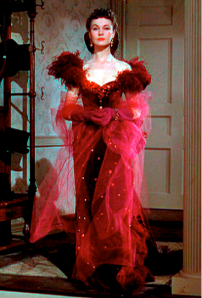Molly A.: Red Dress from Gone with the Wind
Leave a commentOctober 31, 2012 by fashioninguis
The image I am going to talk about is a shot of the red dress that Vivien Leigh as Scarlett O’Hara wears in the 1939 film adaptation of Margaret Mitchell’s Civil War-era novel Gone With The Wind. Fashion is a very important part of the movie, from the various scenes of Scarlett being corseted, to the green bonnet Scarlett receives as a gift but can’t wear because she is in mourning, and especially the infamous curtain dress, the latter of which is perhaps the most well-known piece of clothing from the movie. While maybe not quite as prominent as the latter, there are still lots of things to say about Scarlett’s red dress.
At this point in the movie, Scarlett had just been caught hugging Ashley, the married man that she was in love with, by his sister India, who was not a fan of Scarlett. That night Scarlett was supposed to be attending Ashley’s birthday party, but due to her fear that India had told everyone in town about seeing the two of them together (especially Mellie, Ashley’s wife and one of Scarlett’s only friends), she had decided to skip. However, her husband Rhett (who knew about Scarlett’s feelings for Ashley, as they’d been a constant point of contention between the two) refused to let her do so, picking out a specific dress for her to wear.
The gown is dark red (scarlet, really) with a very low-cut neckline and narrow skirt. It is studded with sparkly jewels, the off-the-shoulder sleeves and hem are covered in feathers and Scarlett is wearing matching gloves and carrying a tulle “wrap.” Her hair is up and off the neck and her only jewelry is a bracelet and earrings, leaving her décolletage startling bare. Unlike some of the other outfits Scarlett wears in the movie, this one is a clear departure from the dress she wears at this part of the novel, which was jade-green and had an enormous bustle with a bunch of pink velvet roses on it. When you compare Scarlett’s dress to the dresses that the other women at the party are wearing, hers is clearly much different, and not just in the color and amount of skin it shows. It’s fitted to her waist and hips and you can clearly see the outline of her body, which is anachronistic for women’s clothes during the Reconstruction period that followed the Civil War.
The screenplay has Rhett verbalize his reasons for picking the dress out, telling Scarlett that “nothing modest or matronly will do for this occasion.” Rather than Scarlett hiding out at home, he forces her to go to the party in a dress that flaunts her assets and makes her “look [the] part” of an adulteress, which the entire town may or may nor believe. When Rhett and Scarlett first got married, she relished in spending his money on lavish clothes, food, and all kinds of goods, after having suffered with so little during the end days of the war and the beginning of Reconstruction. The fact that Scarlett owns a dress like this indicates that she would have no problem wearing it in a different situation, but she certainly would never have chosen it to wear when there are already nasty rumors spreading about her. However, she also does not dare to defy Rhett, which shows how women had a lot less autonomy back then.
It is also interesting to look at this dress in the context of the fact that the costume designer for Gone With The Wind changed what Scarlett originally wore to Ashley’s birthday party. One idea is that they put her in a red dress rather than a green one because they wanted it to stand out from the dress made out of curtains that Scarlett wears earlier in the movie. The style and color of Scarlett’s gown is also very reminiscent of something that Belle Watling, one of Atlanta’s most notorious and prominent prostitutes would wear, and so this may be a way to parallel how society views the sexual morality of both Scarlett and Belle. Additionally, given the fact that Scarlett supposedly has had an affair with Ashley at this point, dressing her in red seems to be a clear homage to Nathanial Hawthorne’s novel The Scarlet Letter, where Hester Prynne was convicted of adultery and forced to sew a scarlet “A” onto all her clothes to mark her permanently. Finally, the bold color of Scarlett’s dress deliberately contrasts very strongly with the pale palette of what the other women at the party that evening were wearing, and this is one more way for the movie to utilize the brand new technology of color film in the best way possible.
Image source: Gone With The Wind, directed by Victor Fleming, Selznick International Pictures, 1939.
For additional information, please see:
Harmetz, Aljean. On The Road To Tara: The Making Of Gone With The Wind. New York: Abrams, 1996.
Nadel, Alex. “What Makes Films Historical?” Film Quarterly 62, No. 3 (Spring 2009): pp. 76-80. http://www.jstor.org/stable/10.1525/fq.2009.62.3.76 (Accessed: October 30, 2012).
Whites, LeeAnn. Gender Matters: Civil War, Reconstruction, And The Making Of The New South. New York : Palgrave Macmillan, 2005.
